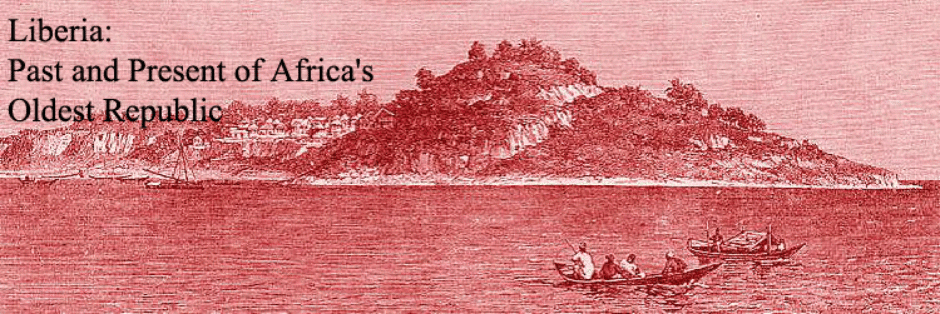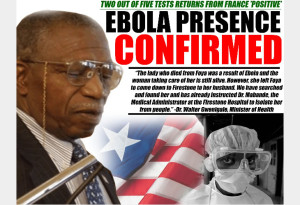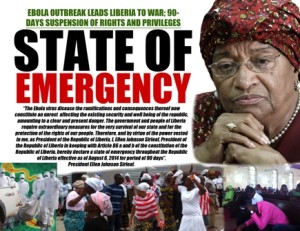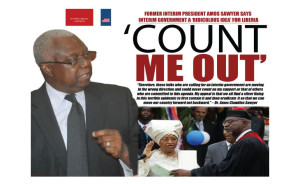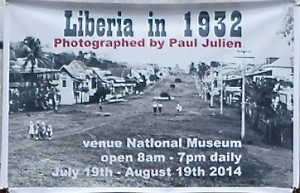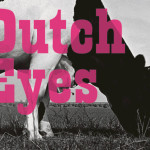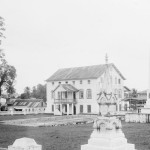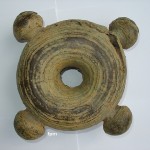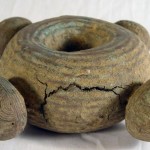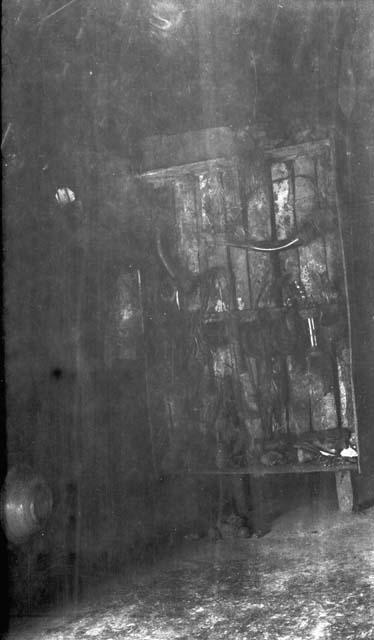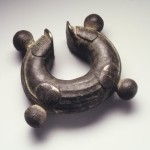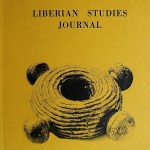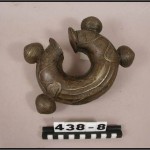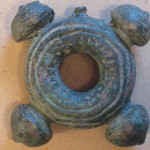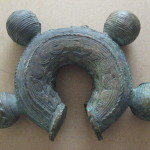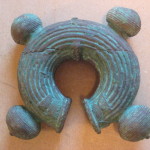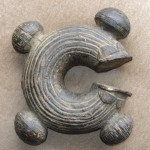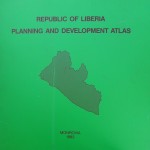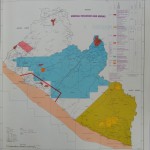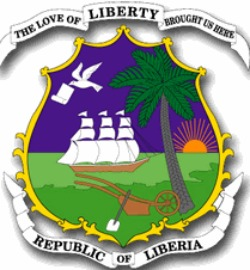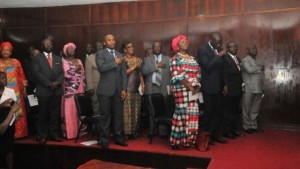 ANNUAL MESSAGE ON THE STATE OF THE REPUBLIC To the Fourth Session of the 53rd National Legislature of the Republic of Liberia, Consolidating For Continuity
ANNUAL MESSAGE ON THE STATE OF THE REPUBLIC To the Fourth Session of the 53rd National Legislature of the Republic of Liberia, Consolidating For Continuity
By: Her Excellency Ellen Johnson Sirleaf President of the Republic of Liberia
(As Delivered)
Mr. Vice President and President of the Senate;
Mr. Speaker;
Honorable Members of the Legislature;
Your Honor the Chief Justice and Associate Justices of the Supreme Court and Members of the Judiciary;
The Dean and Members of the Cabinet and other Government Officials;
Mr. Doyen, Excellencies and Members of the Diplomatic Corps;
Her Excellency, the Special Representative of the Secretary General of the United Nations in Liberia;
The Officers and Staff of the United Nations Mission in Liberia (UNMIL);
The Chief of Staff, Men and Women of the Armed Forces of Liberia (AFL);
Former Chairman of the Interim Government of National Unity, Dr. Amos Claudius Sawyer;
Chairman of the Ruling Unity Party;
Former Officials of Government;
Traditional Leaders, Chief and Elders;
Political and Business Leaders;
Bishops, Pastors, Imams and Religious Leaders;
Officers and Members of the National Bar Association;
Labor and Trade Unions;
Civil Society Organizations;
Members of the Press;
Distinguished Ladies and Gentlemen;
Special Guests;
Fellow Liberians:
Introduction
We assemble here today in compliance with Article 58 of the Constitution which mandates the President on the fourth working Monday in January of each year, to present the Administration’s Legislative Program and report to the Legislature on the State of the Republic covering the economic condition including expenditure and income.
Our agenda during the course of this year was defined virtually by the Ebola virus which threatened our very existence. Our hospital and clinics, as well as our schools closed down; people ran away from their families and homes. Our economy was on the verge of collapse as our citizens and nation were stigmatized. I can say today that despite all of this, our nation has remained strong; our people resilient; our commitment renewed and our faith restored.
Thus I ask that we stand in a moment of silence to honor the memory of the thousands of our people who lost their lives to the Ebola and other related diseases that ravaged our nation, as well as those in the sister nations of Guinea, Sierra Leone, Mali and Nigeria. We deeply feel the pain of the families who lost their love ones. [Silence] Thank you.
Mr. Vice President, I wish to express heartfelt gratitude for your partnership, and commitment to the service of our country and people. Mr. Speaker and Honorable Members of the National Legislature, I thank you, and I thank the former President Pro Tempore of the Senate including the for the able manner in which you managed the affairs of this August Body and for the spirit of cooperation and collaboration which we enjoyed from you during the year. We welcome you back from your Annual Recess and we congratulate the newly elected members as we hope and pray for a year of constructive dialogue in the interest of our nation and people.
Legislative Agenda
Prior to submitting this Administration’s Legislative Agenda, I would like to record our appreciation for the cooperation received from this honorable body that led to the passage of several pieces of legislation relevant to the consolidation of the processes of our Nation’s Agenda for Transformation and the National Vision 2030 which began several years ago to chart a course for Liberia’s growth and sustained development. An examination of the various pieces of legislation reveal that they address challenges of governance, the economy, the rule of law, and our obligations as a responsible member of the international community.
Honorable Legislators, I would like to highlight those instruments which will significantly impact governance, economic transformation, the rule of law, and our international obligations. A sound, firm and attainable economic policy, aimed at Liberia’s economic transformation, demands structural reform of our form of governance.
In this light, in addition to the passage of the Budget Act of 2014/2015, I am pleased for your ratification of the financing agreements between the Government of the Republic of Liberia and Export-Import Bank of India, the Kuwait Fund, the African Development Bank, the African Development Fund, and the International Development Association of the World Bank.
Economic transformation of our nation is not limited only to the public sector, but includes the private sector as well. In a bid to strengthen and expand the capacity of our private sector to contribute to Liberia’s economic transformation, we submitted to your honorable body an amendment to the Mineral Development Agreement among the Government of Liberia, Sesa Goa Limited and Bloom Fountain Limited, and a bill to ratify a Concession Agreement between Government and the Liberia Cocoa Corporation, a wholly Liberian-owned enterprise. These instruments manifest Government’s commitment to generate economic and employment opportunities within key corridors of our country. I commend the impressive work of the gold mining concessionaire, Aureus Mining, in Grand Cape Mount County and I urge all of you to visit the concession site for a personal appreciation of the beneficial results of these arrangements that you have approved.
Working with our sister Republic of Guinea, I will submit legislation to effectuate an infrastructure development agreement between the Government and West African Exploration (WAE) for the transshipment of iron ore from Guinea through Liberia. For several decades the Governments of Liberia and of Guinea have considered and explored modes of cooperation to facilitate the evacuation of iron ore from parts of Guinea near the Liberian border using infrastructure in Liberia. This is a milestone in regional integration opening the way for stronger cooperation between our two countries and broadening the opportunities for large scale investment.
Thank you for enacting the Insurance Act of 2013, and the Payment Systems Act. I will submit additional Bills to support the improvement of the regulatory environment and for financial services in Liberia. This will include: A Bill to Establish a Securities Market in Liberia; A Bill Creating Special Economic Zones; A Bill to Establish an Energy Law to govern the Energy Sector; A Bill to repeal appropriate sections of the Executive Law dissolving the Liberia Produce Marketing Corporation and establishing the Liberia Agriculture Commodity Regulatory Authority. We have already placed before you the Small Business Act to spur the growth of Liberian entrepreneurship and develop the Liberian middle class.
In keeping with our commitment to protect and preserve the environment, I will also submit a bill to establish the Gola National Park and the National Wildlife Conservation and Protected Areas Management Law.
I also ask you to consider passage of Bills to establish the Rubber Development Fund and the Axle Load Act. These bills will impact the level of commercial activity and further empower our people.
I thank you for the several bills passed in support of justice and the rule of law. We note the passage of An Act on the Criminal Conveyance of Land; an Act to Amend the Executive Law, to strengthen the Liberia Drug Enforcement Agency; a new Controlled Drug and Substance Act of 2014; ratification of the Protocol on the Statute of the African Court of Justice and Human Rights; and ratification of the Arms Trade Treaty.
We urge the passage of the Firearms and Ammunition Control Act; the Amendment to the Public Health Law to add a new Chapter on Mental Health; and the Amendment to the Civil Procedure Law on Special Proceedings Concerning Mentally Disabled and Legally Incompetent Persons to be titled the “Mental Health Procedural Act’; and the Amendment to Title 33 of the Executive Law on Reproductive Rights. We will submit a Bill Outlining Procedures for the Exercise of the Constitutional Authority for Expropriation, and a Bill Creating Criminal Court “F” as a specialized court for economic crimes of corruption.
Again, we ask for passage of the amendment to the Act that created the Liberia Anti-Corruption Commission to authorize direct prosecutorial powers for the Commission without the delay caused by the current law which requires the Commission to first refer matters to the Ministry of Justice.
Under your leadership, Mr. Vice President and President of the Senate, a significant number of international agreements and treaties were ratified, all of which demonstrate Liberia’s commitment as a responsible member of the comity of nations. I am especially pleased with the ratification of the Protocol Establishing the Community Court of Justice for ECOWAS, which now makes Liberia a full-fledged member of the ECOWAS Court, and which served as a precursor to Liberia filling a vacancy at the highest ranks of the Court. During this session we intend to submit additional international treaties, conventions, protocols, and agreements for ratification with international organizations.
I will submit a number of legislations that will improve governance – A Bill to Establish the Liberian National Tourism Authority and A New Local Government Act; an Act to amend to the Charter of the University of Liberia; A Bill to Amend the 1989 Act Creating the National Commission on Higher Education; a Bill to Grant Autonomy to the Liberian Board for Nursing and Midwifery, and the Amendment to Liberia Refugee Repatriation and Resettlement Commission Act to expand provisions for refugees and make provisions for asylum seekers and stateless persons. Both bills are already before this Honorable Body.
Honorable Legislators, we will once again ask your consideration of the Act to permit dual citizenship which enables our citizens who are compelled to seek refuge in other countries to become more active participants in the process of nation building.
After lengthy debates and reviews by stakeholders, we are ready to submit, and will urge you to speedily pass into law, the decriminalization of mediarelated offenses in keeping with the Table Mountain Declaration to which we have acceded because it is the right thing to do. This repeal law will advance our democratic aspirations and foster unhindered public debates. We are hopeful that it will improve rather than retard the growing media landscape of the country, and again testify to our continued commitment to an opened society ably supported by a responsible and independent press.
Mr. Speaker, Honorable Members of the Legislature: I issued fourteen Executive Orders extending or renewing previous Executive Orders that dealt with, amongst other things, waiver of taxes and tariffs on anti-malaria commodities and products, exemption of government entities from customs duties on certain products, delimitation of Liberia’s Maritime Zones. The Executive Orders also extended the tenure of the Land Commission continued the moratorium on public land sales, and the establishment of a taskforce against the encroachment on beachfronts, waterways and wetlands.
Economic and Financial Performance
Honorable Speaker and Distinguished Members of the National Legislature, since 2006, Liberia’s growth rate increased, reaching a level of 8.9 percent in 2012 with the potential for double digit thereafter. In 2013, growth rate fell to 8.3 percent on account of the global economic downturn and its effect on global prices of primary commodities.
In 2014, the Ebola virus struck negatively impacting not only our health and social systems, but our economy. Sharp declines in domestic food production, mining activities, cross border trade, transport services and hospitality led to a dramatic decline in our growth rate: from a projected 5.9 percent to an initial -0.4 percent. Although later revised to 1 percent, the future of economic growth is still severely challenged. If we are to achieve development goals outlined in the Agenda for Transformation, and reach the long term average growth rate of 8 percent, radical changes will be required in the structure of our economy for increased investments in the productive sector of the economy and in our governance structure and processes.
The decline in economic activities resulted in reduction in domestic revenue collection and a sharp increase in Government expenditure. Original revenue was revised downwards by US$86 million (from US$559 million to US$473 million) while expenditure demand increased by US$152 million. We introduced tight fiscal measures with expenditure cuts in discretionary activities thereby reducing the fiscal gap by US$33 million.
We also introduced mitigating measures to lessen the impact of the downturn. These included foreign exchange rate stabilization; payment of salaries and wages of civil servants on time; ensuring commercial banks liquidity by settling payments to road contractors and other service providers; and ensuring availability of essential commodities such as rice and petroleum.
In spite of the numerous challenges revenues of US$517.2 million was collected representing 4 percent increase in Tax Revenue and 14 percent increase in Non-Tax Revenue. This included US$12.8 million from Stateowned Enterprises.
The Liberia Revenue Authority (LRA) commenced work on July 1, 2014. Our hope is that with better governance, leadership and an incentive structure our tax Administration will significantly improve revenue performance. This will require cooperation and support from government officials and political authorities accepting that just as we pursue ordinary people and businesses to pay their taxes, the same treatment will be extended to officials of Government in all three branches of government who should commit to bearing their fair share of the tax burden. This is the only sustainable way to finance our national development and improve service delivery to our people.
Expenditure for the period totaled US$530.7 million, an increase of 10.6 percent over the previous year. Recurrent expenditure totaled US$363.5 million of which wages and salaries claimed US$206.8 million or 39 percent and goods and services US$156.7 million or 30 percent. These two items continue to crowd out the fiscal space required for capital expenditure to expand the economy.
Capital expenditure in the Public Sector Investment Plan (PSIP) include US$230 million for the Mount Coffee Hydroelectric plant and US$66 million for three HFO plants and an additional US$200 million was directed to the West Africa Power Pool project between Côte d’Ivoire, Liberia, Sierra Leone and Guinea (CLSG) as well as settlement to various contractors for road works.
Loans contracted from external sources totaled approximately US$138.26 million and approximately US$19.95 million from domestic sources.
External debt service was US$8.56 million with domestic debt service totaling approximately US$41.17 million, including settlement of the Central Bank of Liberia’s US$11.8 million overdraft facilities and US$29.37 million for other domestic debts.
Honorable Speaker and Distinguished Members of the National Legislature, mindful of the past, we are careful to exercise caution in contracting debt. Working with our key development partners, a Medium Term Debt Strategy (MTDS) was adopted as an essential tool in accounting for and analyzing the costs and risks associated with borrowing and ensuring a balance with funding needs. In this manner, debt sustainability is assured.
The total debt stock increased from US$628.45 million to US$759.46 million, of which US$290 Million is owed to the Central Bank of Liberia. This represents 22 percent of GDP.
Honorable Legislature, it is considered ironic by our partners who have granted us significant debt relief that we are unable to convince our own public institutions and private sector entities who have made significant profits over many years to act similarly by relieving us of the debt incurred many years ago under other administrations.
Our development partners have been good friends not only in the fight against Ebola, but in our overall development progress over the past ten years.
Prior to the Ebola outbreak, between January and June 2014, our partners committed a total of US$197.6 million in Official Development Assistance (ODA) to support our Agenda for Transformation. About two-thirds of that amount was invested in the Economic Transformation Pillar to support important infrastructure.
Disbursements were significantly reduced during the second half of the year, due to the outbreak. Although project activities continued sporadically, attention was shifted from our national response to the epidemic. To date, a total of US$244.2 million has been spent on the Ebola response, by Government and our international partners – 49.4 percent is being expended by US Government entities, 24.4 percent by United Nations (UN) entities, 13.3 percent by NGOs, and 12.9 percent Government.
Honorable Speaker and Distinguished Members of the National Legislature. We thank you for the level of cooperation and support during the height of the Ebola outbreak. Without much hesitation, you moved swiftly to grant us special spending authority of US$20 million and the flexibility to raise those resources to intensify our fight against the outbreak. We came together like never before to protect, defend and advance the collective interest of our country and people. Nothing has made us more proud than the urgency and unity which was applied to save our country.
Under the authorized spending of US$20 million, Government contributed US$9 million to establish Ebola Trust Fund, and US$6 million for the restoration of basic health services for a total of US$15 million.
Honorable Speaker, Distinguished Members of the National Legislature, Fellow Liberians, NGOs operating in Liberia continue to be very strong partners in our development work. The speed and effectiveness of response during the Ebola outbreak made tremendous contribution to our national effort.
Last year, I announced several policy measures on the operations of NGOs that are intended, under a compliance and regulatory environment, to strengthen them for proper transparency and accountability of the resources they receive and the results they produce. The Ministry of Finance and Development Planning is to ensure implementation of those measures by finalizing the NGO Policy Guidelines and re-registration process to be announced by the end of the first half of this year. This will transition the registration from a manual computer based system to an online registration process.
This process will enable NGOs to properly account for their operations at the local level where they work, allowing local government to have real time information on what NGO is doing and where. This is consistent with our new drive to de-concentrate and decentralize the delivery of services and to foster greater accountability to local government and citizens structures by the NGOs operating at the local level.
Mr. Vice President, Mr. Speaker, I which to inform you that as we fought on the health front ensuring that the Ebola outbreak was under control, we also had to take appropriate measures on the economic front to ensure that we did not have an collapsed economy.
Under my very clear and emphatic instructions, the Economic Management Team (EMT) coordinated by the Minister of Finance and Development Planning ensured that:
1. Foreign exchange rate remained stable;
2. Civil servants continue to receive their salaries and wages on time;
3. Our commercial banks remained liquid during the crisis;
4. We applaud our Economic Management Team for working together to maintain macroeconomic stability.
The Government, through CBL expanded financial intermediation by promoting throughout the country expansion in commercial banks, foreign exchange bureaux and Savings and Loans Associations. The introduction of a Collateral Registry and promotion of the recently passed Insurance Act are also important milestones. Consistent with policies, the CBL took decisions to improve access to finance for those in rural areas and in the informal sector of the economy. Going beyond this, the CBL took decisions to mitigate the financial burden of school closure in the private schools by committing to settle the debts owed the commercial banks. While we welcome measures that have a positive impact on the lives of our people, we urge caution and more cooperation by the CBL, in the announcement of measures which have implications on our collective targets for sustained national financial viability.
Ebola
Mr. Vice President and President of the Senate, Honorable Members of the Legislature: Liberia’s first case of Ebola was recorded on March 30, 2014 in Foya, Lofa County. Due to the level of cross border movements, the virus spread quickly in the County and then to Margibi with a cross over by a woman marketer. In June, the virus escalated as cases spread throughout Lofa and other counties as well. On June 17, cases were officially reported in Montserrado, including the crowded communities in Monrovia where a third of the country’s population reside. The disease rapidly became an epidemic spreading to all counties in different intensity, the most severe in Monrovia.
Immediate national response and that of the international community as well, was weak given that this was an unknown enemy. Thus Liberia became the poster child of disaster as many lay dying on the streets without access to treatment or to a dignified burial.
We ignored the local and international criticism and went to work establishing the leadership and incidence management structures, increasing social mobilization by engaging and empowering community volunteers, including faith based leaders and constituencies. We aggressively reached out to traditional partners and the international community at large with the message that this was not a Liberia or West African problem, but a potential world problem and menace.
By the end of November, response had shown significant results. Nevertheless, 3,608 of our citizens died, including 178 health care professionals. Our health care system virtually collapsed, airlines, investors, contractors, and citizens as well fled the country. Liberian citizens and residents faced stigmatization and were denied entry into countries worldwide. We faced a chilling projection that 1.3 million or some 20,000 a month would die in the three neighboring affected countries.
We stood tall in rejecting the projection and called for strong collective national action that would lead to zero new cases by Christmas, a target date changed by health officials to end year. In his report dated January 12, 2015 to the President of the General Assembly, the Secretary General of the United Nations reported: “On 31 December, for the first time in months, no new cases were recorded in Liberia.” Honorable Legislators, Ebola was not eradicated on December 31, 2014, but our Incidence Management Team headed by Assistant Minister Tolbert Nyenswah who is here demonstrated the capacity and the commitment to achieve the established target.
Today, we take pride that 13 of our 15 counties have not report any confirmed cases for over 21 days. Lofa, the epicenter of the virus, has had no new cases for over 70 days and the Ebola Treatment Unit in Foya is closed. The 103 beds in 6 Community Care Centers and 13 of the 19 constructed Ebola treatment centers which are currently operational have only 47 patients. We have an average of only 1 – 2 new cases a day in the only two affected counties, Montserrado and Grand Cape Mount County. We have also significantly transitioned from cremation to the more traditional burial practice by opening a new cemetery in Margibi County. Our diligent doctors, supported by partners have brought joy to us by the 1,401 who were cured of the virus, although many have left behind the 3,000 orphans who now require Government love and care.
Distinguished Legislators, our success is due to the many people working hard to contain the virus – the health professionals, the community volunteers, the civil society organizations, the religious institutions, our Armed Forces, officials of Government, national and local, the Legislators, the Judiciary all of whom were participants in the Task Force that was initially established. We owe a lot to our foreign partners, who sent human and material support, who constructed and managed treatment centers, who provided financial resources, who advocated and encouraged us the – United Nations Family through UNMEER, key traditional partners, and many others who joined them; the full listing of which will be given in the Executive Report.
We want to pay tribute to our African brothers and sisters, to the countries that stood by us and came to our rescue when everything seemed to be lost. We want to also express our gratitude to the international community for standing up with us in global solidarity as we faced this deadly disease.
I wish to express particular gratitude to President Goodluck Jonathan, the people and Government of the Republic of Nigeria, who, came to our help, financially and professionally, notwithstanding the fact that they lost loved ones because one of our citizens travelled there with the disease and infected many of their people. Nigeria again proved its leadership on the continent and continued solidarity with the people of Liberia, whenever we faced life threatening difficulties.
At the height of the Ebola outbreak, Liberia made a passionate global appeal for the much needed international humanitarian assistance. The world rallied and responded massively. The United States took the lead followed closely by the People’s Republic of China, Germany, Sweden, Norway, Nigeria, Cuba among others and joined by international development partners such as the European Union, World Bank, African Development Bank, Médecins Sans Frontières (MSF) International, smaller organizations and individuals. Liberia passionately recognizes the numerous human, technical and material assistance of the global community.
We know that we are not out of the woods and must continue relentlessly to continue with the practices and protocols that have brought us this success. We know that we must continue to work with and support our sisterly countries and that we must make an urgent successful transition from treatment to prevention by improving our health care system. But for now let’s take pride and rejoice in our collective success, in the recognition of one of our own, Dr. Jerry Brown who, because of exceptional services, was named Time Magazine Person of the Year. [Dr. Brown is on mission in Geneva.]
Health
The Country’s health care system, with support from partners, had an established decentralized infrastructure system that made notable progress in polio vaccination in reducing the high level of child and maternal mortality and addressing diseases such as malaria, diarrhea, HIV AIDS and Tuberculosis. The Ebola disease exposed the vulnerability of our national health care system which lacked the capacity, the systems and the technical facilities and supplies to respond to infection, particularly an outbreak of this nature and magnitude.
The number of health workers, many inadequately trained, consumed a large share of the budget, resulting in a reliance on partners under the so called “Incentive System.” Medical facilities and equipment, already inadequate, became virtually nonfunctional due to lack of maintenance. The lack of infrastructure – roads, power, water and sanitation – particularly in rural communities compounded the problem.
Liberia has 404 public health facilities, supplemented by 252 private facilities. We still lag significantly behind with 0.4 compared with the African average of 2.6 doctors per 10,000 inhabitants. The record shows that Liberia is one of the leading 10 countries in Africa with over 19 percent of its national budget allocated to health. However, the exposed condition of our health delivery system speaks to the need for sound structure and systems which go beyond professional medical capacity.
A ten year plan developed by the Ministry of Health with support from the Clinton Global Initiative is intended to address the inadequacies in the health system through massive training of health workers and professionals at all levels and an upgrading of the health system and facilities. The Plan, which was formulated before the Ebola crisis is under revision to provide the roadmap for transiting from the treatment of Ebola to a robust health care system that will have facilities for infection control thus preventing a recurrence of the virus and for ensuring better health care delivery to our people.
Education
Education remains a number one priority in the development of Liberia and the most difficult to show positive results in the short term. Statistics for the year 2013 show that there was 5,181 schools (3074 public and 2107 private), with enrollment 1,500,000 students (800,000 boys and 700,000 girls) throughout the country. We have thus succeeded in the achievement of quantity goals by increased enrollment, but quality of education has declined even further, evidenced by the failure in the entrance exam to the University of Liberia and in the WAEC exams which have been set at a substandard level for Liberia. The problem of education goes deeper and beyond the lack of qualified teachers, the lack of facilities and supplies, and the lack of incentive.
The vastness of the challenge and the implication to our overall development effort, compel all of us to come together to formulate bold strategic action to fix it. This is a must for the future of the country and for the education of girls who do not go beyond middle school and are at risk of exploitation.
To solve this problem we hereby announce a program to be implemented in the next fiscal year that will offer financial support to all girls willing to remain in school until the completion of high school.
We call upon all educators, educational institution leaders, eligible concern citizens and partners to join us in a review and update of the Comprehensive Education Reform Program which is underway by the Ministry of Education.
The Ebola Outbreak prevented the opening of schools in September, making virtually idle young people and school teachers. Effort was made to introduce radio instruction and many parents tried to organize selected private sessions while a large number of the more advantage sent their children to schools abroad.
The cost of opening schools, as proposed by public, private schools and higher education’s institutions is simply prohibitive. Making the schools conducive for learning by undertaking the massive renovation required and ensuring that Ebola prevention measures, including provision of clean water and sanitation need to be in place.
The Ministry of Finance and Development Planning is working with the Ministry of Education to determine the way forward in phasing the finances required in order that schools are open on the target date, or not too much later. Widespread consultation is also underway with selected authorities, education leaders, parent teacher associations and community based organizations to inform them on the protocol for the Ebola prevention and to obtain consensus on the need for the early opening of schools to return our students to the business of learning.
Natural Resources
Liberia has a historical primary enclave economy, highly dominated by iron ore, rubber and timber; which subjects it to vagaries in global conditions and prices. Over time, the structure has been changing, with the expansion of agriculture into more traditional tree crops such as coffee, cocoa and oil palm. Essentially, production of crops come from individual and small entity holders with limited capacity to produce on the scale that leads to industrialization. Recent effort by the Government sought to change this by promoting large scale oil palm, using the investment and the experience of Malaysia and Indonesia which have become emerging economic giants.
Agriculture lands (suitable for crops and livestock) are about 27 percent of total land area, but only 4.6 percent of the land mass is currently under annual cultivation. Land and the conflicts associated thereto have to be tackled in order to promote large scale agriculture in tree and food crops including the goal of self-sufficiency in rice.
Honorable Members of the National Legislature, we have responded to the problem with a new Land Policy. The Land Rights Bill, submitted to you, represents a landmark piece of legislation. It establishes the legal basis for recognition of customary land rights. For the first time in the nation’s history rural communities will be able to have their land rights legally recognized, and their lands identified, delineated, mapped, deeded, recorded, and properly managed and governed. Implementation and enforcement will be helped by the Criminal Conveyance of Land Bill which curtails fraudulent land sales and enhances access to land tenure security. These instruments are critical to our social political and economic development and are consistent with our development programs.
Forestry has been a major contributor to the economy in terms of revenue and job creation. Liberia which has 43 percent of the biodiversity of the West African region has come under intense pressure to conserve our forest, thereby contributing to the reduction in carbon dioxide and its negative effect on rapid climate change. Our adoption of new policies that sought to balance conservation, commercialization and community rights have proved less than fully satisfactory. We have gone one step further by concluding a landmark Letter of Intent with the Kingdom of Norway which will provide funding as a contribution to revenue and building of capacity in the Forest Development Authority. The measures under this arrangement will ensure that 30 percent of the country’s remaining forested land and better management and accountability under the continuing program of commercialization.
Iron ore mining, the historical largest export earner, is experiencing severe stress due to decline in global prices. Suspension of activities on account of the Ebola Disease exacerbated the situation leading to a postponement of Phase II of the Arcelor Mittal operation that would have increased production from 5 to 15 million tons per annum. The loss of royalty revenue and jobs from this sector will require your full cooperation in measures that will be proposed to you under our Economic Recovery Plan.
Gold and diamond mining are largely underdeveloped and limited to informal artisanal and small scale operations that are filled with illegal aliens. A project, “Formalization of Artisanal and Small Scale Miners” which seeks to establish a well-structured sector that will be well managed for sustainability and income generation has funding from the German GIZ and is scheduled for implementation early this year.
The 2000 Petroleum law established the National Oil Company (NOCAL) with 30 oil blocks off the Liberian coast. Reform of the Sector started in 2011 with the development and subsequent endorsement of a petroleum policy. Nationwide consultations resulted in a New Petroleum Law 2013. The next step is to formulate draft Acts on Local Content and Petroleum Revenue Management.
The reform measures are intended to ensure full transparency and accountability in the petroleum sector. Your full cooperation in this regard is expected.
Liberianization
Honorable Legislators: We continue to push hard for diversifying our economy beyond two primary commodities. In 2014, we launched the National Trade Policy and our Export Strategy, which provides a roadmap for export diversification particularly in agriculture by broadening our export basket through new investments in fisheries, cocoa, rubber, oil palm, and cassava. Opportunities in tourism are bountiful and deserve further exploration. We will ensure that furniture in schools use our local wood and support the investment proposal to make wood products from dead rubber wood.
I thank you again for passing the Small Business Empowerment Act (SBEA), which calls for 25 percent of all government purchases to be set aside for Liberian owned businesses. The law also provides that 5 percent of the 25 percent, must be set-aside for women-owned businesses. To effectuate this, changes are required in our PPCC law and in our attitudes as we should be prepared to promote and to buy Liberian products made in Liberia, and distributed by Liberians. We take this preferment of our people seriously and call upon everyone, public and private entities to comply fully with this new law of 25 percent or be prepared to face sanctions or legal action.
In further empowerment of our people, I ask everyone to join in promoting the “Wear Your Pride campaign” that would require all government employees to wear, at least once a week preferably Friday, clothing made in Liberia from Liberian products. It is critical to build the demand for local rice through practical strategies that empower the local economy and give us ownership of our economy. Under the “Eat Your Pride Campaign” we will require that only locally grown rice is purchased by government entities that provide rice to their staff.
The local content bill now being drafted will ensure a minimum Liberian participation through joint venture ship or sub-contracting in several areas of national development activity.
Infrastructure
Honorable Legislators, the record is clear that the Government, out of its own resources, domestic or contracted, has constructed throughout the country over 10,000 km of primary, secondary and feeder roads, 650 of which has been paved. The records show that this is more than that done by all previous Governments combined. Our effort to open growth corridors by the pavement of primary roads is a continuing undertaking. Pavement of the Harper to Fishtown road will begin next month; the contractors are now mobilizing, while pavement from Red-light to the Ganta-Guinea border has resumed.
We have resolved that the 26th celebration this year shall be in Greenville and Barclayville. And we will travel there by road.
Development and operational activities at the three major seaports – Monrovia, Buchanan, and Sinoe, made impressive progress in terms of ships serviced and revenue generated when Ebola struck. We will conclude action for the development of the Buchanan Port under the proposal from the French Company Bollare and the Sinoe Port under proposal from the Dutch Company APM, which manages the Freeport Port of Monrovia.
RIA will be modernized. We have concluded arrangements for the construction of the runway and we have invited proposals for a public private partnership that would transfer the development and management of Roberts International Airport to a foreign investor which has similar operations in an ECOWAS Country. This will address the lack of the high capital cost required to develop the airport, particularly in light of the sharply declined financial viability following the loss of traffic due to the Ebola crisis.
We are proud that we brought electricity to the country through the public grid for the first time in two decades, but admit to being far behind in expanding access to a greater number of the population. The cost of electricity at 54 cents per kilowatt hour is probably the highest in the world, since we currently rely on 22.6 MW of high speed diesel generators. The capital cost of power, US$230 million for the Mount Coffee hydro and aggregate US$66 million for the three Heavy Fuel Oil units is high. Once installed these will cause a progressive decline from a current cost of 54 cents, to roughly 15 to 20 cents. This will also remove a major constraint in our plans for value added to some of our primary products and to overall diversification of the economy. This will also lead to significant expansion in the number of customers, both in the Monrovia Consolidation Program as well as the 18 communities in the Southeast. Just today we received approval for an additional 10MW HFO that will also add expansion to our electricity program.
Lack of energy is the major constraint to our development and have based our program for support from the US Millennium Challenge Corporation on the removal of this constraint. Our continued eligibility for Compact has been officially advised. After three years of meeting the rigorous indicators in Economic Freedom, Investing in People and Ruling Justly, we expect to conclude the first phase of the Compact and the financial support which comes from that before the end of this year.
Honorable Legislators, today we have been able to provide to 67 percent of our population with clean water. We have also increased the supply of water from 4 to 6 million gallons a day. However, it is still unacceptable, that a large percentage of our population does not have access to clean pipe borne water. This needs to be addressed and we intend to allocate resources under the County Development Funds to correct this.
Operations for reconstruction of water systems in six county capitals that have been stalled due to the Ebola crisis will soon resume. That will considerably improve access to this life saving resource.
Access to sanitation as defined by international standards is particularly unsatisfactory with 17 percent of the population having adequate facilities. We have to and must change the situation.
Progress, in improving the WASH Sector is impeded by the destruction of underground pipes and illegal property construction over pipes and drainages.
Governance
Honorable Legislators, I am mindful that with the significant progress that will continue to be made in our infrastructure development, we must pay equal attention to what is called the “software projects” – Governance, Peace and Reconciliation, Human Resource Development.
Under governance, we will focus on completion of the Constitution Reform process which would require your legislative endorsement by June 15, thereby enabling us to hold a national referendum by mid-2016. Similar action will be required to conclude our well-conceived and advanced reform in Public Sector and Public Service Reform and in Decentralization.
The restart of the Palava Hut is a must for reconciliation, with support given to the Independent National Commission on Human Rights, which has prime responsibility to guide this important and long delayed process of peace building. The institutional arrangement for the establishment of the Palava Hut is to be concluded within the next three months with my full personal participation in all aspects, as required. We must also accelerate implementation of the Roadmap for National Healing, Peace-building and Reconciliation which has been validated by civil society and is supported by the UN Peace Building Fund through the Ministry of Internal Affairs.
In two weeks, we will celebrate another Armed Forces Day when our gallant men and women in arms will demonstrate their professionalism and will reconfirm proudly the readiness of the engineering battalion to support our construction with public works for national development; just as they did in collaboration with the U.S. Armed Forces during the Ebola crises.
Other security services will also be there to remind us of the shortcomings in our preparations for the UNMIL transition that is targeted for mid-2016. This means we must accelerate our effort and provide significantly more support to meet the training and logistical targets for all security units, particularly the Liberia National Police and the Bureau of Immigration and Naturalization.
Mr. Vice President, Mr. Speaker, Honorable Legislators, some 68 percent of the Liberian population of 4 million are youth between the ages of 15 and 25. Many of our youth have not had the opportunity for formal education beyond the primary level and lack skills for sustained formal employment. They thus represent a large portion of the vulnerable unemployed who are forced to drift from one temporary job to another.
Our Liberian Youth Employment Program (LYEP) launched in March 2013 provided one year employment for over 3000 youths. They worked to improve water and sanitation in 26 cities in the fifteen counties. The program was temporarily suspended due to lack of funding but negotiations with the World Bank are well advanced to provide funding for 25,000 youths to support the remaining component of the program which includes work in ICT, road maintenance, agriculture, health and education.
Similarly, the Beach and Waterways Program initiated by the Maritime Authority which provides employment to 2000 youth will continue with the added benefit of clean beaches for our use.
These efforts can be considered only temporary as we must invest in skills training. We will support technical and vocational education in the facilities and capacity of the Booker Washington Institute. The Concessions will be asked to support the establishment of technical training facilities within their operations. The opening of the Monrovia Vocational and Technical Facility with partnership funding will prepare more of our youths for gainful employment.
Under the project Economic Empowerment of Adolescent Girls and Young women, some 3,500 young women and 1,000 adolescent girls have been trained. Most of them have been employed and over 2,300 have opened their own small businesses. All of this is not enough as we have yet to solve the serious problems of rape, prostitution and the low level of retention in schools. We are forging partnerships with religious institutions to expand their boarding facilities. The government’s pilot Boarding Facility at Gbartala which accommodates 125 girls is under renovation for opening in March. Three more pilot boarding schools will be established in three regions in the next fiscal year.
Trafficking of girls is a crime against humanity. Trafficking in human beings is also a crime against humanity. We will revisit existing policies and work with the Judiciary to impose harsh punishment for convicts, including those who abuse the privilege of living in our country.
Mr. Vice President, Mr. Speaker, Honorable Members of the National Legislature: We have something to celebrate as a nation after successfully conducting the Special Senatorial Elections. We once again register appreciation to the National Elections Commission, all political parties, independent candidates, voters, and the pool of local and international observers whose participation added value to the process.
Honorable Legislators, the media is a very critical ally along the path to good governance. The government’s partnership with the media has been open, frank, and sometimes rocky, but mutually independent. Never before has our country seen an aggressive, thriving and outspokenly critical media landscape amid the abuse in the name of freedom. This government intends to lead a legacy of tolerance and remains fully committed to such process along our journey to democratic maturity. We urge the media which today comprise an unprecedented 35 newspapers and 80 radio stations, to play its part to improve professionalism and responsibility as we will hold them responsible for adherence to our policies and laws. We applaud, in this public manner, the level of cooperation in the media reportage of the Ebola crisis which kept citizens fully informed on the prevailing situation.
Mr. Vice President, Mr. Speaker, Honorable Legislators, the fight against corruption was established as a major goal since the inception of this Administration. We recognized the root causes of this menace – lack of systems, lack of institutions, lack of policies and strategies, poor compensation survival due to deep rooted poverty which characterized all three branches of Government and the nation as a whole.
We made good progress in addressing these deficiencies by establishing integrity institutions – General Auditing Commission, Liberia Anti-Corruption Commission, Public Procurement and Concessions Commissions, Internal Audit Agency, and Liberia Extractive Industry Transparency Initiative. We made even greater progress in developing the systems and improving the level of compensation for all public servants at all levels.
Our performance indicators improved aggressively. Transparency International recognized this. As a competitor in the U.S. program, Millennium Challenge Corporation, we passed consistently for the past three years the index on corruption, which is a single determinant of continuation in the program.
Honorable Legislators, we must continue this fight against corruption through prosecution of persons accused of these malpractices. Our development programs – Roads, Power, Water, Housing, better pay for civil servants – are at risk if we do not do this. Corruption is a vampire of development and the obstruction of progress. I ask that we all commit to fighting this devil that destroys our principles and our pride; that makes us slaves to vested interests. I ask this of you, as respected lawmakers, and I ask for speedier trials from our judiciary.
The report given earlier on efforts to reform our health and education systems are in line with the need for promoting another soft target — improving our human resource. As suggested in my remarks regarding education, more bold and decisive policies and measures are required –such as the establishment of National Centers of Excellence, the promotion of specialized secondary schools. We are developing these concepts into programs of implementation that will be submitted to you for information and for action where required.
The effects of Ebola provide compelling reasons to conclude a national monument project which memorializes all who died from violent conflicts as well as the victims of Ebola. Although there may be other sites equally appropriate, Providence Island, with an uncompleted construction is considered for this purpose. We will also support the Inter-Religious Council which is willing to take the lead in a memorial service to honor those who fell victims to Ebola.
High Level Visitors
Mr. Vice President, Mr. Speaker, Mr. President Pro-Tempore, Honorable Members of the National Legislature: Our country paid host to several high-profiled dignitaries, including:
H.E. Ban Ki-Moon, Secretary –General of the United Nations
Brother Presidents: Ghana, Benin, Niger, Mali
Mr. Mohamed Ould Abdel Aziz, Chairperson, African Union
Dr. Nkosanzana Dlamini Zuma, Chairperson of the African Union
Dr. Kadre Ouedraogo, President of ECOWAS Commission
Hon. Tony Blair, Former Prime Minister, United Kingdom
H.E. Borge Brende, Minister of Foreign Affairs, Norway
Dr. Jim Yong Kim, President of the World Bank
Dr. Margaret Chan, Director General, WHO
Dr. Rajiv Shah, Administrator, USAID
Dr. Thomas Frieden, Head for Centers for Disease Control
US Senator Chris Coons, Chairman of the Subcommittee on Africa
Mr. Anthony Banbury, Special Representative of the Secretary General, UNMEER
Ms. Samantha Powell, Permanent Representative of the United States to the United Nations
Ms. Linda Thomas-Greenfield, US Assistant Secretary of State for African Affairs; among others which will be carried in the Executive Summary.
Necrology
We note with sadness several officials of Government and prominent citizens passed on to the Great Beyond. These include:
H.E. Charles Gyude Bryant – Former Chairman, Transitional Government of the Republic of Liberia
Mr. Bismarck Kuyon, Former Transitional Chair
Most Reverend Boniface Nyem Dalieh – Bishop Emeritus, Catholic Diocese Archbishop
Dr. Williams Nah Dixon, Former President, Liberia Council of Churches
Honorable John F. Whitfield, Former Senator of Grand Bassa County
Hon. Willis D. Knuckles – Former Minister, Ministry of Public Works &State/Pres. Affairs
Honorable Scott Toweh, Former Minister of Agriculture Ambassador
Thomas N. Brima Sr. – Liberia’s Ambassador Extraordinary to Sierra Leone
His Honor Cllr. J.D. Baryogar Junius – Former Associate Justice, Supreme Court of Liberia
Hon. Alhaji Ansumana F. Kromah – Former Commissioner, National Elections Commission
Honorable Dr. S. Jabaru Carlon – Commissioner, Governance Commission
Mrs. Marie Leigh Parker – Former Vice President, NOCAL
Mother Kou Suah Korkpor – Former Renowned Traditional Midwife, Nimba County and many others who will be listed in the Executive Summary
Conclusion
Honorable members of the Legislature, a nation bound together in 2006 vowed to walk away from the destruction and the hurt of the past; vowed to be committed and determined to ensure a future of peace and prosperity for all Liberians. There was not very much then to share or to divert, as we were building from ground zero. In five years we stood together, lifting our nation form the burdens of debt and decay. We worked together to increase revenues, to restore basic services, to remove the heavy debt burden, to mobilize foreign investment, to rebuild the infrastructure, to restore hope.
The world marveled at our tenacity, resilience and determination and reached out massively to help us. Partners committed resources far beyond our domestic effort and our absorptive capacity.
The pain inflicted on our national pride by the Ebola crisis provides an opportunity to search our souls, to ask ourselves if we have been truthful and honest to the commitments made in 2006 when we embarked on this journey together, to ask ourselves if we have served our country and our people well. If never in the past this is the time for us to unite as one government to deliver the promises to our people. There is absolutely no room for blame shifting.
The support in security protection and finance which we enjoy from our partners today, will not last as attention moves away from us to other international priorities. The building of Liberia will rest solely and surely on our shoulders, the shoulders of all Liberians. We will carry this load only if we are prepared to make Liberia our home rather than our intermittent earning place, only if we give back to our country’s development, the resources taken away from it.
I firmly believe that God will give us the strength and the courage to walk boldly into the next few years with a renewed spirit of peace, reconciliation, and commitment to country. We are defeating Ebola and the same spirit of unity and patriotism will enable us together to blow the winds that keep Liberia Rising. May God bless Liberia and save the State.
